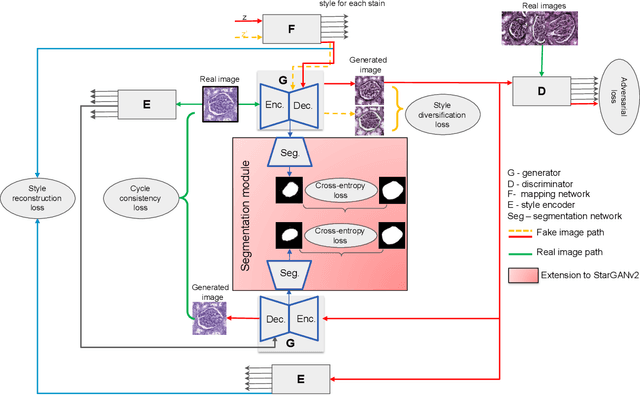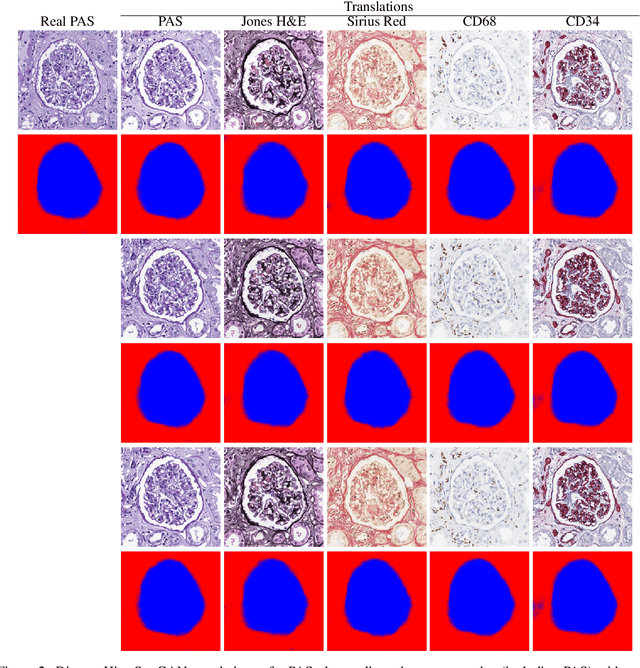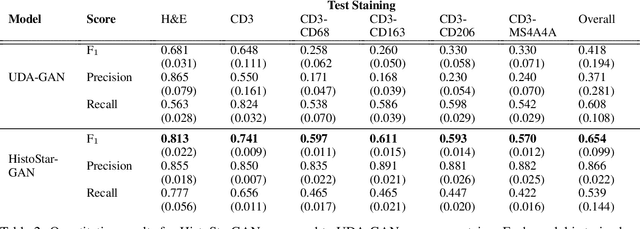Friedrich Feuerhake
Automatic Extraction of Rules for Generating Synthetic Patient Data From Real-World Population Data Using Glioblastoma as an Example
Dec 18, 2025Abstract:The generation of synthetic data is a promising technology to make medical data available for secondary use in a privacy-compliant manner. A popular method for creating realistic patient data is the rule-based Synthea data generator. Synthea generates data based on rules describing the lifetime of a synthetic patient. These rules typically express the probability of a condition occurring, such as a disease, depending on factors like age. Since they only contain statistical information, rules usually have no specific data protection requirements. However, creating meaningful rules can be a very complex process that requires expert knowledge and realistic sample data. In this paper, we introduce and evaluate an approach to automatically generate Synthea rules based on statistics from tabular data, which we extracted from cancer reports. As an example use case, we created a Synthea module for glioblastoma from a real-world dataset and used it to generate a synthetic dataset. Compared to the original dataset, the synthetic data reproduced known disease courses and mostly retained the statistical properties. Overall, synthetic patient data holds great potential for privacy-preserving research. The data can be used to formulate hypotheses and to develop prototypes, but medical interpretation should consider the specific limitations as with any currently available approach.
Spatial Transcriptomics Expression Prediction from Histopathology Based on Cross-Modal Mask Reconstruction and Contrastive Learning
Jun 10, 2025Abstract:Spatial transcriptomics is a technology that captures gene expression levels at different spatial locations, widely used in tumor microenvironment analysis and molecular profiling of histopathology, providing valuable insights into resolving gene expression and clinical diagnosis of cancer. Due to the high cost of data acquisition, large-scale spatial transcriptomics data remain challenging to obtain. In this study, we develop a contrastive learning-based deep learning method to predict spatially resolved gene expression from whole-slide images. Evaluation across six different disease datasets demonstrates that, compared to existing studies, our method improves Pearson Correlation Coefficient (PCC) in the prediction of highly expressed genes, highly variable genes, and marker genes by 6.27%, 6.11%, and 11.26% respectively. Further analysis indicates that our method preserves gene-gene correlations and applies to datasets with limited samples. Additionally, our method exhibits potential in cancer tissue localization based on biomarker expression.
Attention-based Generative Latent Replay: A Continual Learning Approach for WSI Analysis
May 13, 2025



Abstract:Whole slide image (WSI) classification has emerged as a powerful tool in computational pathology, but remains constrained by domain shifts, e.g., due to different organs, diseases, or institution-specific variations. To address this challenge, we propose an Attention-based Generative Latent Replay Continual Learning framework (AGLR-CL), in a multiple instance learning (MIL) setup for domain incremental WSI classification. Our method employs Gaussian Mixture Models (GMMs) to synthesize WSI representations and patch count distributions, preserving knowledge of past domains without explicitly storing original data. A novel attention-based filtering step focuses on the most salient patch embeddings, ensuring high-quality synthetic samples. This privacy-aware strategy obviates the need for replay buffers and outperforms other buffer-free counterparts while matching the performance of buffer-based solutions. We validate AGLR-CL on clinically relevant biomarker detection and molecular status prediction across multiple public datasets with diverse centers, organs, and patient cohorts. Experimental results confirm its ability to retain prior knowledge and adapt to new domains, offering an effective, privacy-preserving avenue for domain incremental continual learning in WSI classification.
Continual Domain Incremental Learning for Privacy-aware Digital Pathology
Sep 10, 2024



Abstract:In recent years, there has been remarkable progress in the field of digital pathology, driven by the ability to model complex tissue patterns using advanced deep-learning algorithms. However, the robustness of these models is often severely compromised in the presence of data shifts (e.g., different stains, organs, centers, etc.). Alternatively, continual learning (CL) techniques aim to reduce the forgetting of past data when learning new data with distributional shift conditions. Specifically, rehearsal-based CL techniques, which store some past data in a buffer and then replay it with new data, have proven effective in medical image analysis tasks. However, privacy concerns arise as these approaches store past data, prompting the development of our novel Generative Latent Replay-based CL (GLRCL) approach. GLRCL captures the previous distribution through Gaussian Mixture Models instead of storing past samples, which are then utilized to generate features and perform latent replay with new data. We systematically evaluate our proposed framework under different shift conditions in histopathology data, including stain and organ shift. Our approach significantly outperforms popular buffer-free CL approaches and performs similarly to rehearsal-based CL approaches that require large buffers causing serious privacy violations.
Tissue Concepts: supervised foundation models in computational pathology
Sep 05, 2024



Abstract:Due to the increasing workload of pathologists, the need for automation to support diagnostic tasks and quantitative biomarker evaluation is becoming more and more apparent. Foundation models have the potential to improve generalizability within and across centers and serve as starting points for data efficient development of specialized yet robust AI models. However, the training foundation models themselves is usually very expensive in terms of data, computation, and time. This paper proposes a supervised training method that drastically reduces these expenses. The proposed method is based on multi-task learning to train a joint encoder, by combining 16 different classification, segmentation, and detection tasks on a total of 912,000 patches. Since the encoder is capable of capturing the properties of the samples, we term it the Tissue Concepts encoder. To evaluate the performance and generalizability of the Tissue Concepts encoder across centers, classification of whole slide images from four of the most prevalent solid cancers - breast, colon, lung, and prostate - was used. The experiments show that the Tissue Concepts model achieve comparable performance to models trained with self-supervision, while requiring only 6% of the amount of training patches. Furthermore, the Tissue Concepts encoder outperforms an ImageNet pre-trained encoder on both in-domain and out-of-domain data.
Unsupervised Latent Stain Adaptation for Computational Pathology
Jul 03, 2024Abstract:In computational pathology, deep learning (DL) models for tasks such as segmentation or tissue classification are known to suffer from domain shifts due to different staining techniques. Stain adaptation aims to reduce the generalization error between different stains by training a model on source stains that generalizes to target stains. Despite the abundance of target stain data, a key challenge is the lack of annotations. To address this, we propose a joint training between artificially labeled and unlabeled data including all available stained images called Unsupervised Latent Stain Adaptation (ULSA). Our method uses stain translation to enrich labeled source images with synthetic target images in order to increase the supervised signals. Moreover, we leverage unlabeled target stain images using stain-invariant feature consistency learning. With ULSA we present a semi-supervised strategy for efficient stain adaptation without access to annotated target stain data. Remarkably, ULSA is task agnostic in patch-level analysis for whole slide images (WSIs). Through extensive evaluation on external datasets, we demonstrate that ULSA achieves state-of-the-art (SOTA) performance in kidney tissue segmentation and breast cancer classification across a spectrum of staining variations. Our findings suggest that ULSA is an important framework for stain adaptation in computational pathology.
Unsupervised Latent Stain Adaption for Digital Pathology
Jun 27, 2024Abstract:In digital pathology, deep learning (DL) models for tasks such as segmentation or tissue classification are known to suffer from domain shifts due to different staining techniques. Stain adaptation aims to reduce the generalization error between different stains by training a model on source stains that generalizes to target stains. Despite the abundance of target stain data, a key challenge is the lack of annotations. To address this, we propose a joint training between artificially labeled and unlabeled data including all available stained images called Unsupervised Latent Stain Adaption (ULSA). Our method uses stain translation to enrich labeled source images with synthetic target images in order to increase supervised signals. Moreover, we leverage unlabeled target stain images using stain-invariant feature consistency learning. With ULSA we present a semi-supervised strategy for efficient stain adaption without access to annotated target stain data. Remarkably, ULSA is task agnostic in patch-level analysis for whole slide images (WSIs). Through extensive evaluation on external datasets, we demonstrate that ULSA achieves state-of-the-art (SOTA) performance in kidney tissue segmentation and breast cancer classification across a spectrum of staining variations. Our findings suggest that ULSA is an important framework towards stain adaption in digital pathology.
Applications of artificial intelligence in the analysis of histopathology images of gliomas: a review
Feb 05, 2024Abstract:In recent years, the diagnosis of gliomas has become increasingly complex. Analysis of glioma histopathology images using artificial intelligence (AI) offers new opportunities to support diagnosis and outcome prediction. To give an overview of the current state of research, this review examines 70 publicly available research studies that have proposed AI-based methods for whole-slide histopathology images of human gliomas, covering the diagnostic tasks of subtyping (16/70), grading (23/70), molecular marker prediction (13/70), and survival prediction (27/70). All studies were reviewed with regard to methodological aspects as well as clinical applicability. It was found that the focus of current research is the assessment of hematoxylin and eosin-stained tissue sections of adult-type diffuse gliomas. The majority of studies (49/70) are based on the publicly available glioblastoma and low-grade glioma datasets from The Cancer Genome Atlas (TCGA) and only a few studies employed other datasets in isolation (10/70) or in addition to the TCGA datasets (11/70). Current approaches mostly rely on convolutional neural networks (53/70) for analyzing tissue at 20x magnification (30/70). A new field of research is the integration of clinical data, omics data, or magnetic resonance imaging (27/70). So far, AI-based methods have achieved promising results, but are not yet used in real clinical settings. Future work should focus on the independent validation of methods on larger, multi-site datasets with high-quality and up-to-date clinical and molecular pathology annotations to demonstrate routine applicability.
Overcoming Data Scarcity in Biomedical Imaging with a Foundational Multi-Task Model
Nov 16, 2023Abstract:Foundational models, pretrained on a large scale, have demonstrated substantial success across non-medical domains. However, training these models typically requires large, comprehensive datasets, which contrasts with the smaller and more heterogeneous datasets common in biomedical imaging. Here, we propose a multi-task learning strategy that decouples the number of training tasks from memory requirements. We trained a Universal bioMedical PreTrained model (UMedPT) on a multi-task database including tomographic, microscopic, and X-ray images, with various labelling strategies such as classification, segmentation, and object detection. The UMedPT foundational model outperformed ImageNet pretraining and the previous state-of-the-art models. For tasks related to the pretraining database, it maintained its performance with only 1% of the original training data and without fine-tuning. For out-of-domain tasks it required not more than 50% of the original training data. In an external independent validation imaging features extracted using UMedPT proved to be a new standard for cross-center transferability.
HistoStarGAN: A Unified Approach to Stain Normalisation, Stain Transfer and Stain Invariant Segmentation in Renal Histopathology
Oct 18, 2022



Abstract:Virtual stain transfer is a promising area of research in Computational Pathology, which has a great potential to alleviate important limitations when applying deeplearningbased solutions such as lack of annotations and sensitivity to a domain shift. However, in the literature, the majority of virtual staining approaches are trained for a specific staining or stain combination, and their extension to unseen stainings requires the acquisition of additional data and training. In this paper, we propose HistoStarGAN, a unified framework that performs stain transfer between multiple stainings, stain normalisation and stain invariant segmentation, all in one inference of the model. We demonstrate the generalisation abilities of the proposed solution to perform diverse stain transfer and accurate stain invariant segmentation over numerous unseen stainings, which is the first such demonstration in the field. Moreover, the pre-trained HistoStar-GAN model can serve as a synthetic data generator, which paves the way for the use of fully annotated synthetic image data to improve the training of deep learning-based algorithms. To illustrate the capabilities of our approach, as well as the potential risks in the microscopy domain, inspired by applications in natural images, we generated KidneyArtPathology, a fully annotated artificial image dataset for renal pathology.
 Add to Chrome
Add to Chrome Add to Firefox
Add to Firefox Add to Edge
Add to Edge